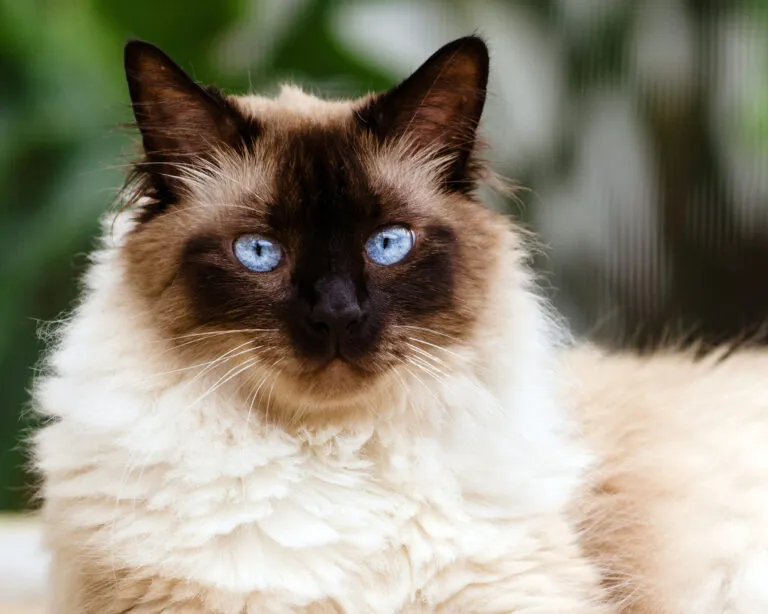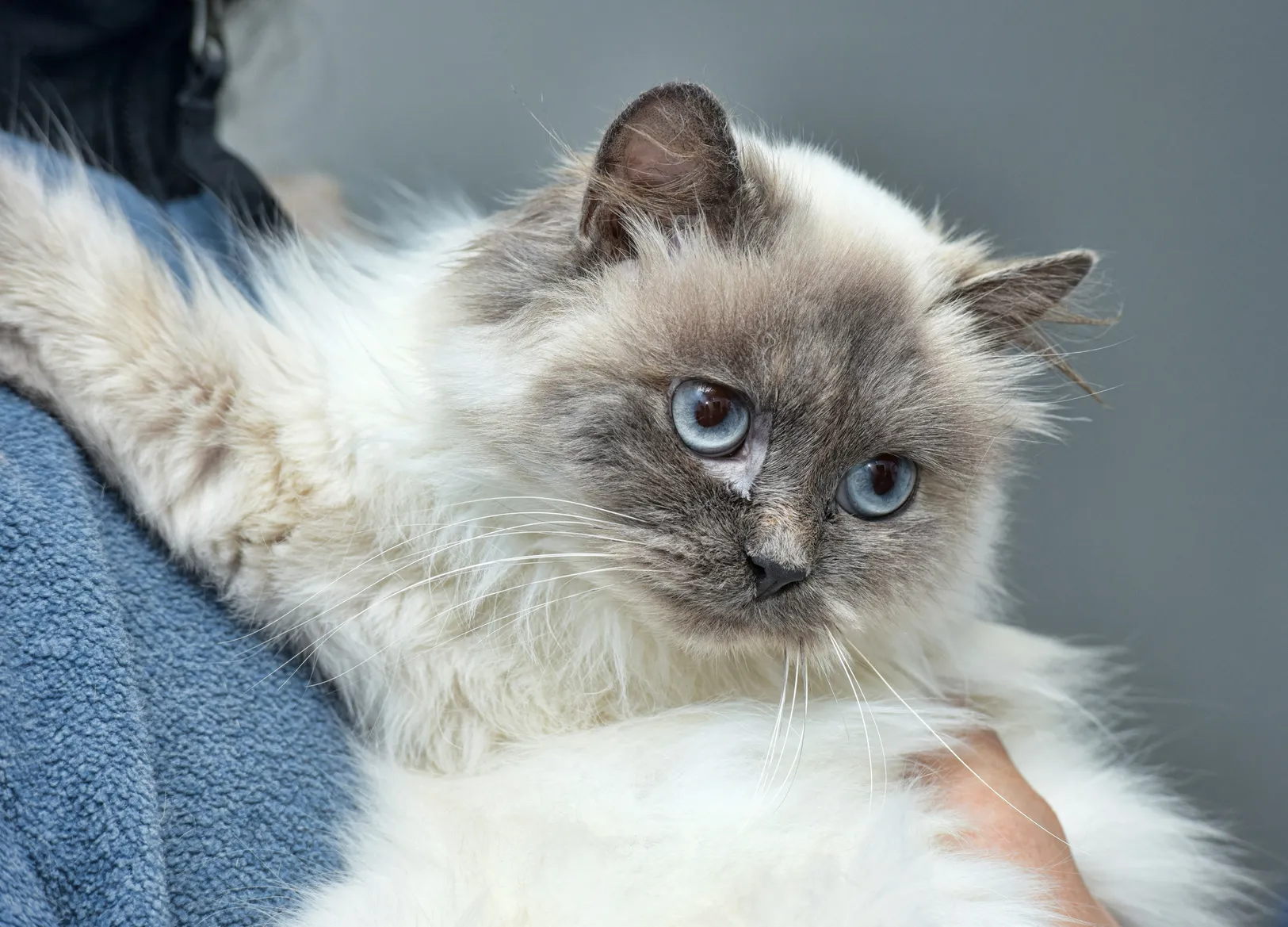Maine Coon
The Maine Coon has become one of the most popular cat breeds in the world. This is probably due to its majestic appearance, robust nature and great character.
The cuddly Himalayan came about through pairing Siamese and Persian cats. The striking point colouration in the face has given it the name “Persian in disguise”. In addition, the term “Colourpoint Persian” is occasionally used. Some class the Himalayan as an independent breed, whilst others sees it as a special variation on the Persian.

© Robert Hainer / stock.adobe.com
In the 1920s, the cat breeder Virginia Cobb and Dr. Clyde Keeler, a researcher from Harvard Medical School, laid the foundations for a new breeding programme. Dr. Clyde Keeler was at that time researching the gene responsible for the emergence of colour points on cats. The objective of the breeding programme was to breed a cat with the fur of a Persian, along with the blue eyes and markings of a Siamese. This led to the birth of the Himalayan cat.
The Himalayan cat is a medium to large sized cat with a short body. Its legs are short and stocky and the bone structure is very strong. The chest and back are broad and the Himalayan has a strong tail that is bushy and well-proportioned to the rest of the body. This relatively rare breed tends to be impressive in weight: males weigh up to 10kg and females up to 8kg. The head is round and its typical point nose is short and compressed. The ears are small and round. Its large eyes are bright blue, round and wide-spaced. The fur is long and silky with a thick undercoat and can be found in the colours seal, tortie, seal point and blue point. Himalayan cats have the Persian cat’s long fur and very unique points around its face, ears, paws and tail, just like the Siamese.
The Himalayan is classed according to the Persian standard, although it resembles the Siamese in terms of its nature. However, the character of the two breeds from which the Himalayan was bred could hardly be more different.
The Siamese part comes to the fore with the lively character, whilst it can be concluded that the gentle and pleasant side comes from the personality of the Persian.
The Himalayan prefers to grant its affection to people it trusts. Moreover, it is a bit selective when it comes to who it loves. In particular, they love long cuddles with people who have conquered their heart. These felines are fundamentally very much drawn to their beloved human housemates.
The sensitive Himalayan feels ill at ease in loud environments or households with too much hustle and bustle. Its nature is served best by a calm environment with people who are quieter.
You should brush the Himalayan’s long fur on a daily basis with a soft cat brush in order to maintain its attractive appearance. Otherwise, the fur can become matted quickly and form knots. Regular brushing will strengthen the connection between you and your beloved feline friend.
You should also give your “Himmy”, as it is lovingly known, a bath once a month, along with carefully cleaning the face once a day to keep your dear cat clean and healthy. Also, dirt quickly gets caught in the paws due to the long fur. You should cautiously clean the paws if possible.
Himalayan cats have a tendency to gain weight. Therefore, you should choose food with this in mind and monitor its weight.
Unfortunately the Himalayan is relatively prone to different clinical symptoms. For instance, it typically has a tendency to suffer from diseases affecting the respiratory tract. Questionable breeding practices can also make the Himalayan’s nose so compact that it suffers from shortness of breath. Animal-rights activists often raise justified concerns regarding such examples of what is known as torture breeding.
 © Evdoha / stock.adobe.com
© Evdoha / stock.adobe.com
The Himalayan cat’s tendency to gain weight should be considered when it comes to its diet. Apart from this, the same nutritional recommendations largely apply to the Himalayan as to other pedigree and non-pedigree cats.
We will outline here different diet options:
Some experts describe BARF as the most species-appropriate diet because it is most similar to the cat’s diet in the wild. The highest proportion of their naturally chosen sustenance is accounted for by raw meat. A very small amount is made up by grain that the cat consumes through the contents of a mouse’s stomach, for instance.
Wet food has the advantage of 80% moisture content. This is recommended, since cats in general consume few fluids and wet food helps to ensure sufficient liquid consumption.
Due to the danger of allergies or intolerances, the food should not contain any unnecessary chemical components. Other fillers, by-products or preservatives can also harm your cat. If the food is high quality, it can also have the advantage of making your cat’s faeces smell less!
When it comes to wet food, make sure you solely choose high-quality products. These don’t have to be more expensive than low-quality alternatives. Test results from recognised institutions can provide information on this. High-quality food has a large proportion of premium protein and is easy for feline stomachs to digest. It should provide calories without encouraging weight gain.
While some have an unfavourable opinion on dry food, there are many supporters too, with some cat experts even exclusively opting for dry food. Dry food has the advantage of being very convenient for the cat’s human housemates: it doesn’t start to develop an unpleasant smell if it is left out for a long time – in contrast to wet food. When it comes to dry food, you should ensure that your cat consumes sufficient fluids, especially if you solely choose this method. You can guarantee a sufficient fluid intake by providing drinking fountains or bowls away from the feeding area. After all, cats consume food and water in separate areas in their natural environment.
You can always recognise responsible breeders by certain characteristics, such as the cats being integrated in the breeder’s household and family life. This guarantees that kittens already recognise typical domestic noises like the hoover and other loud appliances when they enter your home. If not, little kittens could be quite scared when faced with such noises – cats don’t usually encounter them in the wild. Nevertheless, many breeders naturally have a separate cat room, in which the felines can really let off steam with scratching trees and climbing posts.
A reputable breeder should be a member of a recognised breeding association, where breeders offer each other mutual support. Trustworthy cat breeders offer advice and are interested in the welfare of the kittens that have grown up in their homes. Hence, they will answer all your questions regarding your Himalayan willingly and competently. You may wish to ask a breeder about the kitten’s parents and the frequency of litters. Good cat breeders are experts in genetics and have an idea of which cat breeds should not be paired with each other under any circumstances. Most good breeders specialise in one to two breeds, since breeding cats demands very extensive specialised knowledge.
Hygiene is also a very important factor. You can primarily recognise a trustworthy breeder by cat bowls and litter boxes being found in an impeccable state. Cats themselves are considered incredibly clean and set great store by their litter box being cleaned regularly and thoroughly.
It is very important for kittens from a responsible breeder to only be rehomed from the age of 12 weeks and mostly together with a sibling rather than alone. A good breeder will draw up a purchase contract with you, outlining how to proceed if unexpected problems emerge with the kitten. The breeder also gives you tips regarding how to feed your new feline friend. Himalayan cat in the UK likely costs somewhere between £500 and £1,500
Finally, your intuition is also a valuable source of advice that shouldn’t be dismissed when it comes to choosing the right breeder. It’s completely up to you whether you choose a cat from an animal shelter or a responsible breeder.
| Feature | Description |
| Origin | Not a natural breed, developed by breeding Persians and Siamese |
| Size | Medium |
| Activity Level | Moderately active |
| Temperament | Gentle, Quiet, Sweet-tempered, Intelligent, Polite |
| Coat | Longhaired with thick undercoat |
| Color | Point coloration (seal, chocolate, blue, lilac) with darker mask, ears, legs, and tail; cream body |
| UK Price: | Himalayan cat in the UK likely costs somewhere between £500 and £1,500 |
| Weight: | up to 8 kg (females) up to 10 kg (males) |
Here are some purchase proposals curated by the zooplus editorial team
The products featured have been carefully selected by our editorial staff and are available at the zooplus online pet shop. The selection does not constitute advertising for the mentioned brands.
The Maine Coon has become one of the most popular cat breeds in the world. This is probably due to its majestic appearance, robust nature and great character.
Large eyes and attentively upright ears instantly tell you a great deal about this charming breed of cat: Abyssinians are inquisitive and affectionate towards people.
With its long, dense fur, rounded ears, and intense stare, the Pallas Cat, or Manul, looks rather fluffy, yet somewhat dangerous. However, don't be fooled by its appearance—this is no petting zoo resident. The Manul is a wild animal and considered untameable.